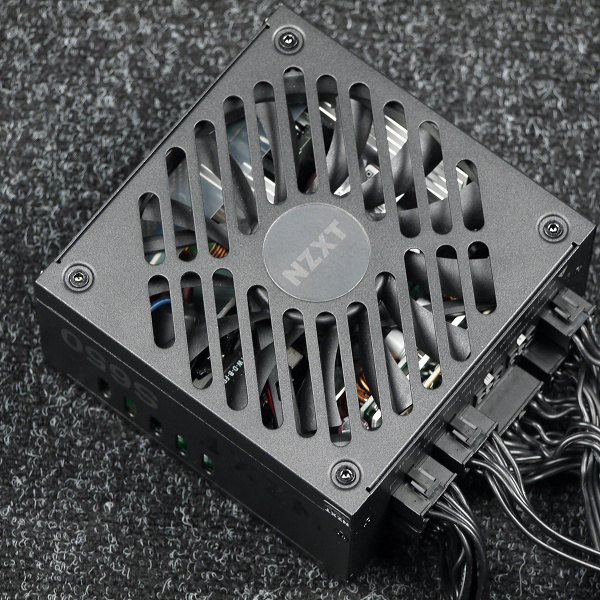
It is not so often that cases with a built-in power supply come to our test, but now just such a case. We have already met the NZXT H1 case itself, and now it’s time to talk in more detail about its power supply. It should be noted right away that complete power supplies have a number of nuances, and it is not entirely correct to compare them in some respects with retail products.
In this case, we have an SFX-L format power supply, that is, with an SFX mount, but with a case length increased to 125 mm. The stamped grille is very reminiscent of the Seasonic models, which no one hides – there is a direct indication on the label that the PSU was manufactured at this enterprise.
Characteristics
All the necessary parameters are indicated on the power supply case in full, for the power of the + 12VDC bus, the value of 648 W is declared. The ratio of +12VDC bus power to full power is 0.997, which is, of course, an excellent indicator.

Wires and Connectors
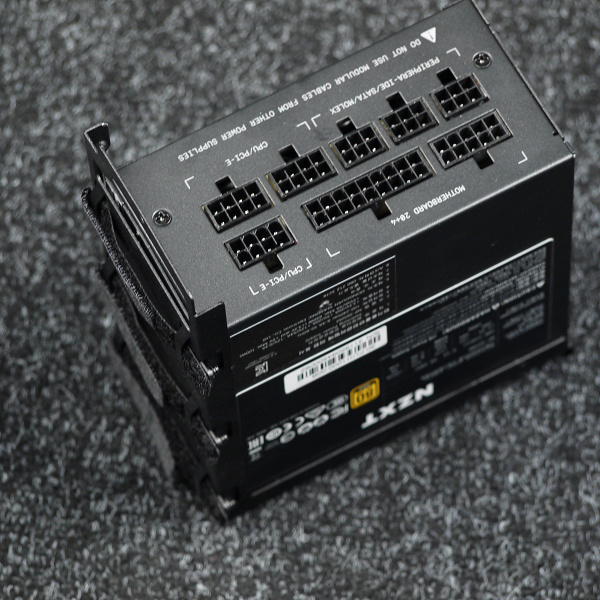
| Connector name | Number of connectors | Notes |
|---|---|---|
| 24 pin Main Power Connector | one | collapsible |
| 4 pin 12V Power Connector | — | |
| 8 pin SSI Processor Connector | one | collapsible |
| 6 pin PCI-E 1.0 VGA Power Connector | — | |
| 8 pin PCI-E 2.0 VGA Power Connector | 4 | on two cords |
| 4 pin Peripheral Connector | — | |
| 15 pin Serial ATA Connector | 2 | on 1 cord |
| 4 pin Floppy Drive Connector | — |
Without exception, all wires are modular, that is, they can be removed, leaving only those that are necessary for a particular system. True, in this particular case there is nothing special to shoot, you can only remove one cable to power the video card, since there are two of them, although the NZXT H1 case is designed for one video card.
A very modest number of SATA Power connectors is due to the capacity of the case: it is designed only for two drives that are installed side by side.
On the positive side, it is worth noting the use of ribbon wires to the connectors, which increases ease of assembly.
Circuitry and cooling
The layout of the elements inside the power supply demonstrates the competent approach of developers to the issue of cooling. The main heating elements are located along the air flow coming out of the PSU, and not across it, as is implemented in some models of the SFX format. There is also a minimum of wires inside the power supply – everything is assembled on jumpers or contacts without the use of flexible connections, which allows you to free up space for more efficient air exchange inside the PSU case, as well as reduce aerodynamic resistance to air flow created by the fan.
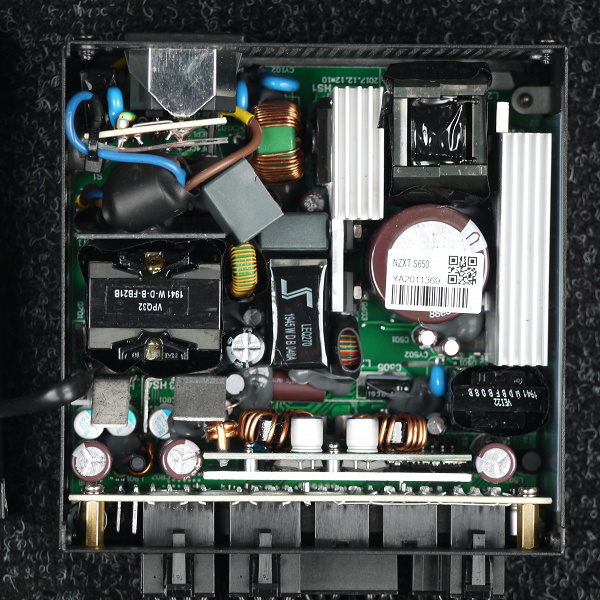
However, the developers failed to completely avoid the problems associated with the layout of such power supplies: a dense mounting of elements near the exhaust hole in the PSU case is noticeable, which will create additional resistance to the outgoing air flow. But this feature is quite typical for computer power supplies, even in full-size cases.
The design of the power supply is in line with modern trends: an active power factor corrector, a synchronous rectifier for the +12VDC channel, and independent switching DC converters for the +3.3VDC and +5VDC lines.
High-voltage power elements are installed on two medium-sized radiators, synchronous rectifier transistors are installed on the back side of the main printed circuit board, elements of pulse converters of + 3.3VDC and + 5VDC channels are placed on a daughter printed circuit board installed vertically, there is even a small heat sink.

The power supply has Japanese-made liquid electrolyte capacitors. In the bulk, these are products under the Nippon Chemi-Con and Nichicon trademarks. A large number of polymer capacitors have also been installed.

The power supply is equipped with a low-profile 120 mm fan – S1201212HB manufactured by Globe Fan. The fan is based on a hydrodynamic bearing and has a maximum rotation speed of 2200 rpm.
Measurement of electrical characteristics
Next, we turn to an instrumental study of the electrical characteristics of the power source using a multifunctional stand and other equipment.
The value of deviation of output voltages from the nominal value is color-coded as follows:
| Colour | Deviation range | Qualitative assessment |
|---|---|---|
| more than 5% | unsatisfactory | |
| +5% | bad | |
| +4% | satisfactorily | |
| +3% | well | |
| +2% | very good | |
| 1% or less | Great | |
| −2% | very good | |
| −3% | well | |
| −4% | satisfactorily | |
| −5% | bad | |
| more than 5% | unsatisfactory |
Working at maximum power
The first stage of testing is the operation of the power supply at maximum power for a long time. Such a test with confidence allows you to verify the performance of the PSU.

Cross load characteristic
The next stage of instrumental testing is the construction of a cross-load characteristic (CNC) and its presentation on a quarter-plane, limited by the maximum power on the 3.3 & 5 V bus on the one hand (along the ordinate axis) and the maximum power on the 12 V bus on the other (along the abscissa axis). At each point, the measured voltage value is indicated by a color marker depending on the deviation from the nominal value.
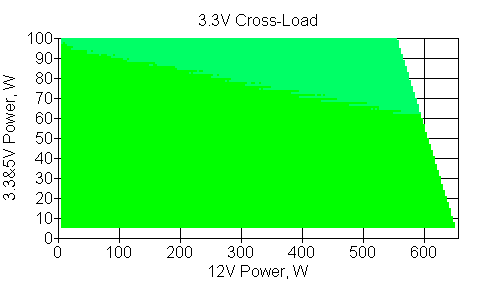
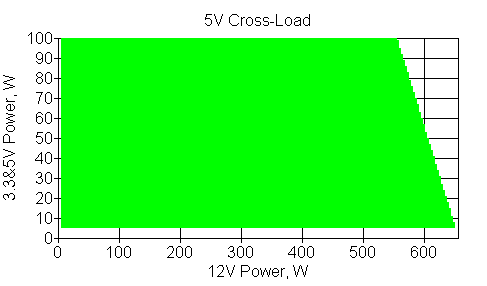
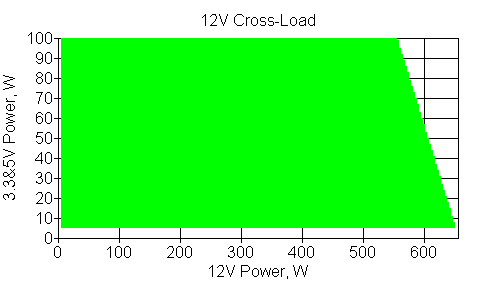
KNH allows us to determine what level of load can be considered acceptable, especially on the + 12VDC channel, for the instance under test. In this case, the deviations of the effective voltage values from the nominal value through the +12VDC channel do not exceed 1% in the entire power range, which is an excellent result.
With a typical power distribution over the channels, deviations from the nominal value do not exceed 1% for the +3.3VDC, +5VDC and +12VDC channels.
This PSU model is well suited for powerful modern systems due to the high practical load capacity of the + 12VDC channel.
load capacity
The following test is designed to determine the maximum power that can be supplied through the appropriate connectors with a normalized voltage deviation of 3 or 5 percent of nominal.

In the case of a video card with a single power connector, the maximum power through the +12VDC channel is at least 150 W with a deviation of 3%.

In the case of a video card with two power connectors, when using one power cord, the maximum power through the +12VDC channel is at least 250 W with a deviation within 3%.

In the case of a video card with two power connectors, when using two power cords, the maximum power through the +12VDC channel is at least 300 W with a deviation of 3%, which allows you to use very powerful video cards.

When loaded through the processor power connector, the maximum power through the +12VDC channel is at least 250 W with a deviation of 3%. This allows you to use desktop platforms of any level, having a tangible margin.

In the case of the motherboard, the maximum power on the +12VDC channel is over 100 W with a deviation of 3%. Since the board itself consumes within 10 W on this channel, high power may be required to power expansion cards – for example, for video cards without an additional power connector, which usually have a consumption of around 75 W.
Economy and efficiency
When evaluating the efficiency of a computer power supply, there are two ways to go. The first way is to evaluate the computer power supply as a separate electrical energy converter with a further attempt to minimize the resistance of the power transmission line from the PSU to the load (where the current and voltage at the PSU output are measured). To do this, the power supply is usually connected with all available connectors, which puts different power supplies in unequal conditions, since the set of connectors and the number of current-carrying wires are often different even for power supplies of the same power. Thus, although the results are correct for each specific power supply, in real conditions the data obtained is of little use, since in real conditions the power supply is connected to a limited number of connectors, and not all at once. Therefore, it seems logical to determine the efficiency (economics) of a computer power supply not only at fixed power values, including power distribution over channels, but also with a fixed set of connectors for each power value.
Representing the efficiency of a computer power supply in the form of an efficiency value (coefficient of performance) has its own traditions. First of all, efficiency is a coefficient determined by the ratio of the output and input powers of the power supply, that is, the efficiency shows the efficiency of converting electrical energy. For an ordinary user, this parameter will tell almost nothing, except that a higher efficiency seems to indicate greater efficiency of the PSU and its higher quality. But efficiency has become a great marketing anchor, especially when combined with the 80Plus certification. However, from a practical point of view, efficiency does not have a noticeable effect on the functioning of the system unit: it does not increase performance, does not reduce noise or temperature inside the system unit. This is just a technical parameter, the level of which is mainly determined by the development of the industry at the current time and the cost of the product. For the user, maximizing efficiency results in an increase in the retail price.
On the other hand, sometimes you need to objectively evaluate the efficiency of a computer power supply. By efficiency, we here mean the loss of power during the conversion of electricity and its transmission to end consumers. And to evaluate this efficiency is not needed, since you can use not the ratio of two values, but absolute values: power dissipation (the difference between the values u200bu200bof the input and output of the power supply), as well as the energy consumption of the power supply for a certain time (day, month, year etc.) when working with a constant load (power). This makes it easy to see the real difference in power consumption of specific PSU models and, if necessary, calculate the economic benefit of using more expensive power supplies.
Thus, at the output we get a parameter that is understandable to everyone – dissipated power, which is easily converted into kilowatt-hours (kWh), which is recorded by the electric energy meter. Multiplying the obtained value by the cost of a kilowatt-hour, we get the cost of electrical energy, provided that the system unit is operated around the clock throughout the year. Such an option, of course, is purely hypothetical, but it allows you to evaluate the difference between the cost of operating a computer with different power sources for a long period of time and draw conclusions about the economic feasibility of purchasing a particular PSU model. In real conditions, the calculated value can be achieved over a longer period – for example, from 3 years or more. If necessary, everyone can divide the obtained value by the desired coefficient, depending on the number of hours per day during which the system unit is operated in the specified mode in order to obtain electricity consumption for the year.
We decided to single out several typical options in terms of power and correlate them with the number of connectors that correspond to these options, that is, to bring the method of measuring efficiency as close as possible to the conditions that are achieved in a real system unit. At the same time, this will allow you to evaluate the efficiency of different power supplies in completely identical conditions.
| Load through connectors | 12VDC, W | 5VDC, W | 3.3VDC, W | Total power, W |
|---|---|---|---|---|
| main ATX, processor (12 V), SATA | 5 | 5 | 5 | fifteen |
| main ATX, processor (12 V), SATA | 80 | fifteen | 5 | 100 |
| main ATX, processor (12 V), SATA | 180 | fifteen | 5 | 200 |
| main ATX, processor (12V), 6-pin PCIe, SATA | 380 | fifteen | 5 | 400 |
| main ATX, processor (12V), 6-pin PCIe (1 cord with 2 connectors), SATA | 480 | fifteen | 5 | 500 |
| main ATX, processor (12 V), 6-pin PCIe (2 cords by 1 connector), SATA | 480 | fifteen | 5 | 500 |
| main ATX, processor (12V), 6-pin PCIe (2 cords of 2 connectors), SATA | 730 | fifteen | 5 | 750 |
The results are as follows:
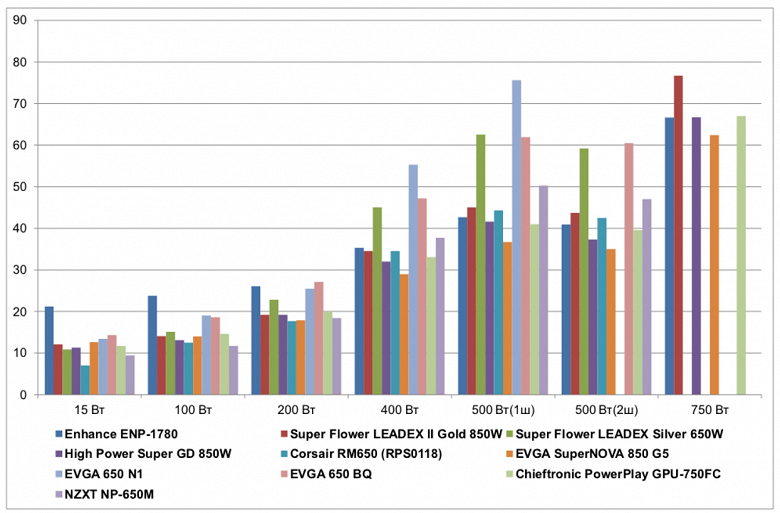
| Dissipated power, W | 15 W | 100 W | 200 W | 400 W | 500 W (1 cord) |
500 W (2 cords) |
750 W |
|---|---|---|---|---|---|---|---|
| Enhance ENP-1780 | 21.2 | 23.8 | 26.1 | 35.3 | 42.7 | 40.9 | 66.6 |
| Super Flower Leadex II Gold 850W | 12.1 | 14.1 | 19.2 | 34.5 | 45 | 43.7 | 76.7 |
| Super Flower Leadex Silver 650W | 10.9 | 15.1 | 22.8 | 45 | 62.5 | 59.2 | |
| High Power Super GD 850W | 11.3 | 13.1 | 19.2 | 32 | 41.6 | 37.3 | 66.7 |
| Corsair RM650 (RPS0118) | 7 | 12.5 | 17.7 | 34.5 | 44.3 | 42.5 | |
| EVGA Supernova 850 G5 | 12.6 | fourteen | 17.9 | 29 | 36.7 | 35 | 62.4 |
| EVGA650N1 | 13.4 | nineteen | 25.5 | 55.3 | 75.6 | ||
| EVGA 650 BQ | 14.3 | 18.6 | 27.1 | 47.2 | 61.9 | 60.5 | |
| Chieftronic PowerPlay GPU-750FC | 11.7 | 14.6 | 19.9 | 33.1 | 41 | 39.6 | 67 |
| NZXT NP-S650M | 9.4 | 11.7 | 18.4 | 37.7 | 50.3 | 47 |
In general, this model is at the level of solutions with a similar level of certificate, it does not show anything outstanding, but there are no failures either. It’s just a product on a modern platform with modern features.
Yearly expense:
| Computer energy consumption per year, kWh | 15 W | 100 W | 200 W | 400 W | 500 W (1 cord) |
500 W (2 cords) |
750 W |
|---|---|---|---|---|---|---|---|
| Enhance ENP-1780 | 317 | 1085 | 1981 | 3813 | 4754 | 4738 | 7153 |
| Super Flower Leadex II Gold 850W | 237 | 1000 | 1920 | 3806 | 4774 | 4763 | 7242 |
| Super Flower Leadex Silver 650W | 227 | 1008 | 1952 | 3898 | 4928 | 4899 | |
| High Power Super GD 850W | 230 | 991 | 1920 | 3784 | 4744 | 4707 | 7154 |
| Corsair RM650 (RPS0118) | 193 | 986 | 1907 | 3806 | 4768 | 4752 | |
| EVGA Supernova 850 G5 | 242 | 999 | 1909 | 3758 | 4702 | 4687 | 7117 |
| EVGA650N1 | 249 | 1042 | 1975 | 3988 | 5042 | ||
| EVGA 650 BQ | 257 | 1039 | 1989 | 3918 | 4922 | 4910 | |
| Chieftronic PowerPlay GPU-750FC | 234 | 1004 | 1926 | 3794 | 4739 | 4727 | 7157 |
| NZXT NP-S650M | 214 | 979 | 1913 | 3834 | 4821 | 4792 |
However, at low and medium power, the efficiency is quite high:
| Tue | |
|---|---|
| Enhance ENP-1780 | 106.4 |
| Super Flower Leadex II Gold 850W | 79.9 |
| Super Flower Leadex Silver 650W | 93.8 |
| High Power Super GD 850W | 75.6 |
| Corsair RM650 (RPS0118) | 71.7 |
| EVGA Supernova 850 G5 | 73.5 |
| EVGA650N1 | 113.2 |
| EVGA 650 BQ | 107.2 |
| Chieftronic PowerPlay GPU-750FC | 79.3 |
| NZXT NP-S650M | 77.2 |
Temperature regime
In this case, in the entire power range, the thermal load of the capacitors is at a satisfactory level, which can be positively assessed, taking into account the dimensions of the PSU case.
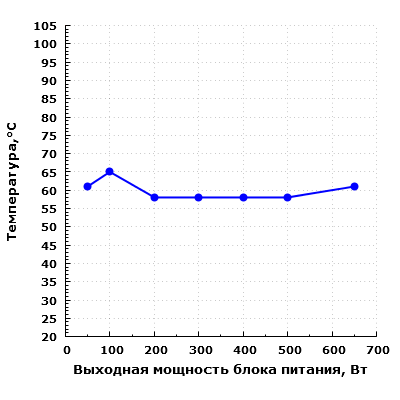
We studied the functioning of the power supply in the hybrid mode of the cooling system. It was found that in this model the fan is turned on and off only depending on the temperature on the thermal sensor, which is typical for solutions based on Seasonic platforms, while some other hybrid power supplies use the fan on and off depending on temperature and power. But despite using only the temperature channel to run the fan, the developers managed to create a cooling system that ensures that there are no sudden temperature fluctuations when running at constant power, which in itself is not an easy task.
The fan turns on when approaching a temperature of about 64 degrees, turns off – about 60 degrees, that is, the range is quite narrow. When running at about 200-300 watts, this results in quite frequent start/stop cycles, which sometimes looks like a sharp change in fan speed. At a power of 100 W or less, the power supply can work for a long time with the fan stopped.
It should also be taken into account that in the case of operation with the fan stopped, the temperature of the components inside the PSU is highly dependent on the ambient air temperature, and if it is set at 40-45 °C, this will lead to an earlier turning on of the fan.
Acoustic ergonomics
In preparing this material, we used the following method for measuring the noise level of power supplies. The power supply is located on a flat surface with the fan up, above it at a distance of 0.35 meters is placed the measuring microphone of the Octava 110A-Eco sound level meter, which measures the noise level. The power supply is loaded using a special stand that has a silent mode of operation. During the noise level measurement, the power supply is operated at constant power for 20 minutes, after which the noise level is measured.
Such a distance to the measurement object is the closest for a desktop placement of a system unit with an installed power supply. This method allows you to evaluate the noise level of the power supply in harsh environments in terms of a small distance from the noise source to the user. As the distance to the noise source increases and additional barriers appear that have good sound reflecting ability, the noise level at the control point will also decrease, which will lead to an improvement in acoustic ergonomics in general.
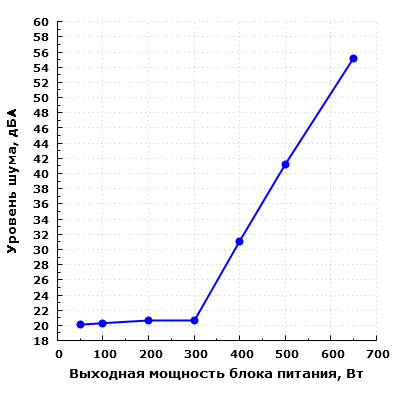
When operating in the range up to 300 W inclusive, the noise of the power supply is at the minimum noticeable level – less than 23 dBA from a distance of 0.35 meters.
When operating at a power of 400 W, the noise level of this model approaches the average typical value when the PSU is located in the near field. With a more significant removal of the power supply and placing it under the table in a case with a lower PSU location, such noise can be interpreted as being at a level below average. During the daytime in a residential area, a source with a similar noise level will not be very noticeable, especially from a distance of a meter or more, and even more so it will be hardly noticeable in an office room, since the background noise in offices is usually higher than in residential areas. At night, a source with such a noise level will be clearly visible, it will be difficult to sleep nearby. A similar noise level can be considered comfortable when working at a computer.
With a further increase in output power, the noise level increases markedly.
At a load of 500 W, the noise of the power supply already exceeds the value of 40 dBA when placed on a desktop, that is, when the power supply is located in the near field in relation to the user. This noise level can be described as quite high.
When operating at a power of 650 W, the noise is very high not only for residential, but also for office space.
Thus, in terms of acoustic ergonomics, this model provides comfort with an output power of up to 400 W, and up to 300 W the power supply is very quiet.
We also evaluate the noise level of the power supply electronics, since in some cases it is a source of unwanted overtones. This stage of testing is carried out by determining the difference between the noise level in our laboratory with the power supply on and off. If the obtained value is within 5 dBA, there are no deviations in the acoustic properties of the PSU. With a difference of more than 10 dBA, as a rule, there are certain defects that can be heard from a distance of about half a meter. At this stage of measurements, the sound level meter microphone is located at a distance of about 40 mm from the upper plane of the PSU, since it is very difficult to measure electronic noise at greater distances. The measurement is carried out in two modes: standby mode (STB, or Stand by) and when the PSU is working on the load, but with the fan forcedly stopped.
In standby mode, electronic noise is almost completely absent. In general, the electronics noise can be considered relatively low: the excess of background noise was no more than 7 dBA.
Consumer qualities
Consumer qualities NZXT NP-S650M are at a high level, if we consider the use of this model in a home system that uses typical components assembled in a compact package. The consumption of such systems, with very rare exceptions, does not exceed 350 watts.
The NZXT NP-S650M allows you to assemble a relatively quiet gaming system on a mid-budget modern desktop platform with a single graphics card, which can be made almost silent in minimal load modes. The acoustic ergonomics of the PSU up to 400 W inclusive is quite comfortable, but it can deteriorate with an increase in the ambient temperature.
We note the high load capacity of the platform via the +12VDC channel, as well as the decent quality of power supply of individual components and efficiency. Our testing did not reveal significant shortcomings.
On the positive side, we note the complete set of the power supply with Japanese capacitors and a fan on a hydrodynamic bearing.
Results
The NZXT NP-S650M is a quality power supply that will certainly please potential buyers of the NZXT H1 case from which it was removed, but is unlikely to help those who would like to buy another case and are looking for a suitable SFX-L PSU. At the same time, this is a good reference point with which to compare other SFX-L PSUs, since there are not so many models of this format and not all of them deserve kind words.




